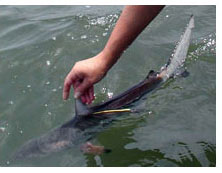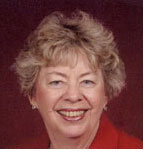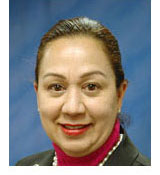

 |
||||||
 |
||||||

Tagged Shark a Record for Mote Scientists
Just under nine years later – 3,158 days to be exact – a shark tagged by scientists with Mote Marine Laboratory’s Center for Shark Research was recaptured, setting a new record for the tagging program which encompasses more than 15,000 sharks of 16 species since 1991.
 The “baby” blacktip shark tagged at less than a year old in Charlotte Harbor’s Pine Island Sound in 1996 was recaptured in late 2005 off Boca Grande Pass. “This demonstrates that these tags can stay on the sharks for many years, which is important for this type of research,” said Bob Hueter, director of Mote’s shark research programs.
The “baby” blacktip shark tagged at less than a year old in Charlotte Harbor’s Pine Island Sound in 1996 was recaptured in late 2005 off Boca Grande Pass. “This demonstrates that these tags can stay on the sharks for many years, which is important for this type of research,” said Bob Hueter, director of Mote’s shark research programs.
A second record was set by a blacktip initially tagged in the Florida Keys in 2002 and recaptured in the Florida Panhandle – some 437 miles away. “This shows us that young sharks can travel great distances during their seasonal migrations,” said Hueter.
Mote scientists tagged 700 sharks last year and fishermen can help scientists in their studies – and earn the chance to win a cash prize – by keeping an eye out for yellow or orange plastic tags attached near a shark’s first dorsal fin. The tags can sometimes be overlooked because of growth of marine algae on the surface of the tag. Fishermen are asked to cut the tag off if possible and send it to Mote or simply write down the tag number and mail or phone in that information.
Pinellas Gains Four More Clean Marinas
Four marinas – including Marino’s Marina in Palm Harbor, St. Petersburg Yacht Club, Harborage Marina at Bayboro and MAR-Marina in Tarpon Springs – have joined the state’s Clean Marina program, bringing the county’s total to 13.
“That’s 11.5% of all the Clean Marinas in the state and we’re one of the smallest counties,” says Gene Quinn, senior environmental specialist for the county. The Clean Marina program (see Bay Soundings, Summer 2004) requires that marinas evaluate their operations, implement a series of environmental housekeeping measures specific to their site and educate boaters on ways to minimize impacts.
Other Clean Marinas in Pinellas include Caladesi Island State Park Marina, Tierra Verde Marina, Clearwater Municipal Marina, Home Port Marina, Gulfport Municipal Marina, St. Petersburg Municipal Marina, Safety Harbor Municipal Marina, Largo Intercoastal Marina and Isla Del-Sol Yacht & Country Club. For more information, contact www.cleanboatingpartnership.com.
Governor Appoints Two New Members to Water Management Governing Board
 Gov. Jeb Bush recently appointed two new members to the Governing Board of the Southwest Florida Water Management District Board: Sallie Parks of Palm Harbor (pictured left), to succeed Watson Haynes II, and Maritza Rovira-Forino of Tampa (pictured lower right), succeeding Janet Kovach. Todd Pressman of Clearwater, president of Pressman and Associates, was reappointed to the board. Their terms end March 1, 2010.
Gov. Jeb Bush recently appointed two new members to the Governing Board of the Southwest Florida Water Management District Board: Sallie Parks of Palm Harbor (pictured left), to succeed Watson Haynes II, and Maritza Rovira-Forino of Tampa (pictured lower right), succeeding Janet Kovach. Todd Pressman of Clearwater, president of Pressman and Associates, was reappointed to the board. Their terms end March 1, 2010.
Parks is a former Pinellas County Commissioner (1992 to 2000) and retired lobbyist for St. Petersburg College . She was the first executive director of the Pinellas County Arts Council and directed public relations and marketing for Meese Health Care for 10 years. As past president of the Rotary Club of Dunedin, she helped raise over $200,000 to build an environmental education center at Honeymoon Island State Park. Parks also is founder of PACE Pinellas, a program for at-risk girls.
 Rovira-Forino is a community volunteer who has served as a member of the Northwest Hillsborough River Basin Board since 2002. A native of San Juan, Puerto Rico she moved to Orlando in 1986 where she served as director of the Greater Florida Minority Development Council. Since moving to Tampa in 1991, she has been a marketing manager for J.A. Jones/Metric Constructors and seven Florida offices of PSI Engineers. Rovira-Forino is a member of the USF Latin Advisory Board, Mayor’s Hispanic Advisory Committee and a board member of the American Red Cross.
Rovira-Forino is a community volunteer who has served as a member of the Northwest Hillsborough River Basin Board since 2002. A native of San Juan, Puerto Rico she moved to Orlando in 1986 where she served as director of the Greater Florida Minority Development Council. Since moving to Tampa in 1991, she has been a marketing manager for J.A. Jones/Metric Constructors and seven Florida offices of PSI Engineers. Rovira-Forino is a member of the USF Latin Advisory Board, Mayor’s Hispanic Advisory Committee and a board member of the American Red Cross.
California Takes Steps to Halt Marine Invaders
The California State Lands Commission recently proposed regulations that would create the nation’s toughest ballast water standards by 2016, with a “zero-organism” standard by 2020.
California law currently requires that ships calling on state ports from international waters manage their ballast water, but it still allows for the transfer of organisms. While exact details of the new plan aren’t yet finalized, the proposal may entail onboard treatment of ballast water sterilized through a chemical agent such as chlorine and ozone, or by ultraviolet light treatment.
Large vessels can carry more than 5 million gallons of ballast water, which help ships maneuver and maintain stability; they also transport aquatic hitch-hikers from distant shores that can wreak havoc on ecosystems in other countries. Billions of gallons of ballast water are dumped along California’s shores each year, including an estimated one billion gallons into San Francisco Bay alone, where 99% of the organisms are believed to be non-native.
Pinellas Agrees to Purchase Marina
The Pinellas County Commission has agreed to purchase a 5.5-acre marina in Tarpon Springs for $12 million. The Landing at Tarpon Springs, with 230 high-dry units and 31 wet slips, also includes 12 marine-oriented businesses such as a marine supply store and a bait and tackle shop.
The purchase follows recommendations of a task force created last year to ensure public access even as long-time marinas are purchased and redeveloped as upscale condominiums. “This is a very high priority for us and we’ve gotten a lot of public support,” said Jake Stowers, assistant county administrator.
Humpback Whale Freed From Life-Threatening Entanglement
A juvenile humpback whale entangled in rope off the east coast of Florida in March was rescued by a team of biologists from the Florida Fish and Wildlife Research Institute, the National Oceanographic and Atmospheric Administration and Georgia Department of Natural Resources.
Researchers believed buoys and rope embedded in the humpback’s tail were life-threatening but they were able to free the 25- to 28-foot whale after five hours work, and it swam away safely. Scientists took tissue samples during the operation to gather genetic information and details about the whale’s general health.
The initiative was coordinated by the large-whale disentanglement network, a partnership of state, federal and non-governmental agencies along the East Coast. Members have extensive field experience and equipment to report, monitor and document entangled whales and assist in their rescue.
|
In Memoriam Jack Wilson
As head of The Wilson Company, Wilson was a key player behind several notable projects including Carillon office park near Feather Sound and the New York Yankee’s Legends Field. He is crediting with helping establish the Westshore area as a viable office space alternative to downtown. But it was Bayport Plaza, an office and hotel complex on Tampa Bay that includes the Hyatt Regency Westshore and Oystercatchers restaurant, that was his signature project – acclaimed as much for its natural, mangrove-studded shoreline as anything else. “Jack was a visionary who saw the great potential for integrating development and the environment, and understood that these ideas were not incompatible,” says wetland ecologist Robin Lewis. Lewis designed the shoreline project, winner of numerous environmental awards including the coveted Florida Audubon Corporate Award in 1985. A boardwalk wends through the wetland providing optimum vantage points from which to view the bay and wildlife. The wetland is a haven for sea birds increasingly crowded out when shoreline habitat is destroyed; the magnificent roseate spoonbill is one of its dazzling patrons. Roy Harrell Jr.
Harrell is widely credited as architect of the The Partnership Plan, the strategic document that outlined the region’s new alternative water supply sources including desalination and the Hillsborough County Reservoir. Harrell also authored the 1997 interlocal agreement binding six local governments to bay restoration commitments outlined in the Tampa Bay Estuary Program’s Comprehensive Conservation & Management Plan. He was also active in the Tampa Bay Chapter of the American Red Cross, St. Anthony’s Hospital Foundation and United Way, and was a past president of the St. Petersburg Chamber of Commerce. Two years ago, the West Central Florida Council of the Boy Scouts honored him for his efforts on behalf of scouting. He is survived by his wife, Virginia “Ginny”; a daughter, Stacey L. Springsteen, St. Petersburg; a son, Michael T., St. Petersburg; and three grandchildren. |
Fisheries Update: Hooked on Snook, Drops in Red Drum
Profile: Artist Diane Peebles & Researcher Ernst Peebles
Ports Prepare for Heavy Weather
How to Become a Change Agent: Lessons in Social Marketing
Biomimicry: Borrowing Ideas from Nature
Local Photographers Help Celebrate Estuary Program's 15th Anniversary
Special Insert: Pinellas County Summer Camps & Special Events